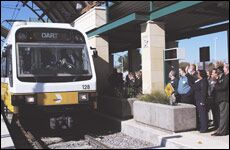
Light Rail Progress can be contacted at: Light Rail Progress |
Light rail transit (LRT) is currently on a very fast track in metropolitan Dallas right now. Extensions into key Dallas suburbs have been opening ahead of schedule and under budget. On 18 November 2002, Dallas Area Rapid Transit (DART) opened its Blue Line branch into downtown Garland, a suburb to the northeast of downtown Dallas. The Forest/Jupiter Station was also opened. Meanwhile, the Red Line branch into Plano, another suburban city north of central Dallas, is preparing for a December 9th startup.
"We're very excited about the arrival of DART Rail" said Garland
Mayor Dr. Bob Day. "Not only will Garland at long last have easy
access to all of the Metroplex, but this will serve as a major
stimulus for the economic growth already under way here." "I think you will see people riding trains into downtown
Garland as well as riding them from Garland into Dallas" Dr. Day told the Dallas Morning News. "Every day Garland residents travel to jobs throughout the Metroplex, and people in surrounding cities commute to Garland's major employers" observed Gary Thomas, DART president/executive director. "With our expansion, Garland's most popular work, shopping, and entertainment destinations are just steps or a short bus ride from our rail stations. And, if you live in Garland, you've got a great new way to get around the region without fighting the traffic."
Attractive Stations With an expanded light rail system of nearly 41 miles and 31 stations, the new stations are expected to become new economic development generators for Garland, a city that has grown from early agricultural roots to become one of Texas's leading industrial centers.
Art by design artist Celia Alvarez Munoz reflects the Native American watering holes once near the site with paving stones in wave designs. A tower with a clock imbedded stands above the station, recalling the vintage railroad station standing under the watchful eye of the venerable clock tower, a sight once prevalent in town squares around the region. The Downtown Garland Station is expected to have to deal with more than its share of commuters - from Sachse and Rowlett - looking for a parking space. Further extensions already in planning will eventually move the system closer to those areas and relieve pressure on the station.
At this station, design artist David Hickman has depicted the area's rural beginnings with plow-shaped fence railings and a heavily landscaped entrance area. Round cast-concrete columns with stainless steel capitals represent the move to industrialization. A wind-activated sculpture by artist Susan Pascal Beran complements the station design and signals the future growth. DART projects that, by the end of 2003, an average of about
1,400 passengers will board trains at the Forest/Jupiter Station
each weekday and that nearly 2,000 will do the same at downtown
Garland. Big Boost for Downtown Garland With the extension, DART Rail's Blue Line now links downtown Garland with far south Oak Cliff. DART has also enacted bus route changes to intersect with the rail extension and help connect bus passengers with the trains. According to Patty Granville, Garland's cultural facilities director,
people who have been parking elsewhere to ride LRT will come to
downtown Garland now, and many who have been coming
downtown for events at the Performing Arts Center and the Plaza
Theatre will have an easier way to get there. And they will find reasons to come even more frequently, Kali Wood of Main Street Garland told the Dallas News. "The historical feel is still there, and we have a lot to offer entertainment-wise, with the Garland Civic Theater, the Performing Arts Center and the Plaza Theatre" Wood emphasized. "We have restaurants and shops, and the quaintness and charm are still there. And hopefully, we're going to see people living downtown again." Excitement Over TOD The LRT extension has also stimulated interest among community decisionmakers in transit-oriented development, or TOD. Earlier, on Saturday morning, November 16th, Garland city officials and business and community leaders convened to discuss TOD possibilities at the mobile Northside Downtown Conference at the downtown rail station. The group rode a train to Mockingbird Station for a tour, then to the Galatyn Park Station for a briefing by Richardson city staff. They then had lunch at Plano's downtown station and heard a panel discussion on transit-oriented development. Panelists included Plano and Richardson elected officials and staff, and developers who have been active in the Galatyn Park and Mockingbird Station areas. "The arrival of the DART rail line in Garland gives us a new opportunity to enhance Garland's economy, accessibility and image through appropriate development" Dr. Day said. "This conference will help us focus on a plan of action to turn this opportunity into a reality." Anita Russelmann of the Garland Planning Department said the conference was designed to help Garland leaders bring transit-oriented development to their city. "The panel was designed to be a mixture of all the people who are involved in the development process. it was the mayor's intention that this panel would tell us what we need to do to stimulate development in the station areas." Red Line Heads Toward Plano Meanwhile, DART's Red Line, currently linking the Westmoreland Station in southwest Dallas to Galatyn Park in Richardson, will be extended on December 9th with new stations opening in Plano (see map above). The three suburban rail stations opening Dec. 9th represent the last stops within DART's current expansion era. With the 3.2-mile, $62.8 million section to Plano finished six months ahead of schedule, the new branch illustrates how cost-effectively and affordably LRT can be incremented to reach out to suburban areas. The Plano extension has cost the agency less than $20 million per mile – and for first-class, highspeed rapid transit, with attractive, secure stations, not a bus operation camouflaged to be a "light rail look-alike". When the Plano branch opens, DART will have 44 miles of light-rail lines and 34 stations. Updated 2002/12/03 |
|
|
|